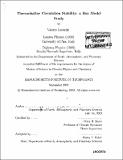Thermohaline circulation stability : a box model
Author(s)
Lucarini, Valerio
DownloadFull printable version (15.30Mb)
Other Contributors
Massachusetts Institute of Technology. Dept. of Earth, Atmospheric, and Planetary Sciences.
Advisor
Peter H. Stone.
Terms of use
Metadata
Show full item recordAbstract
A thorough analysis of the stability of uncoupled and coupled versions of an inter-hemispheric 3-box model of Thermohaline Circulation (THC) is presented. The model consists of a northern high latitudes box, a tropical box, and a southern high latitudes box, which respectively can be thought as corresponding to the northern, tropical and southern Atlantic ocean. We study how the strength of THC changes when the system undergoes forcings that are analogous to those of global warming conditions. In each class of experiments, we determine, using suitably defined metrics, the boundary dividing the set of forcing scenarios that lead the system to equilibria characterized by a THC pattern similar to the present one, from those that drive the system to equilibria where the THC is reversed. In the case of the uncoupled model, we apply to the equilibrium state perturbations to the moisture and heat fluxes into the three boxes. High rates of increase in the moisture flux into the northern high-latitude box lead to a THC breakdown at smaller total final increases in the moisture flux than low rates, while the presence of moisture flux increases into the southern high-latitude box strongly inhibit the breakdown and can prevent it, in the case of slow rates in the Northern Hemisphere. Similarly, a fast heat flux increases in the North Hemisphere destabilize the system more effectively than slow ones, and again the enhancement of the heat fluxes in the Southern Hemisphere tend to drive the system towards stability. In all cases analyzed slow forcings, if sufficiently weak in the Southern Hemisphere, lead to the reversal of the THC. (cont.) In the coupled model a direct representation of the radiative forcing is possible, since the main atmospheric physical processes responsible for freshwater and heat fluxes are formulated separately. Although only weakly asymmetric or symmetric radiative forcings are representative of physically reasonable conditions, we consider general asymmetric forcings, in order to get a more complete picture of the mathematical properties of the system. We also consider different choices for the atmospheric transport parametrizations and for the ratio between the high latitude to tropical radiative forcing, and analyze the sensitivity of our results to changes in these parameters. We generally find that fast forcings are more effective than slow forcings in disrupting the present THC patterns, forcings that are stronger in the northern box are also more effective in destabilizing the system, and that very slow forcings do not destabilize the system whatever their asymmetry, unless the radiative forcings are very asymmetric and the atmospheric transport is a relatively weak function of the meridional temperature gradient. The changes in the strength of the THC are primarily forced by changes in the latent heat transports, because of their sensitivity to temperature that arises from the Clausius-Clapeyron relation.
Description
Thesis (S.M.)--Massachusetts Institute of Technology, Dept. of Earth, Atmospheric, and Planetary Sciences, 2003. Includes bibliographical references (leaves 87-97).
Date issued
2003Department
Massachusetts Institute of Technology. Department of Earth, Atmospheric, and Planetary SciencesPublisher
Massachusetts Institute of Technology
Keywords
Earth, Atmospheric, and Planetary Sciences.